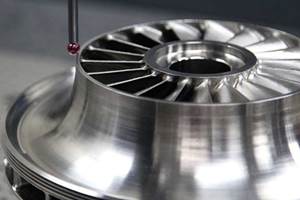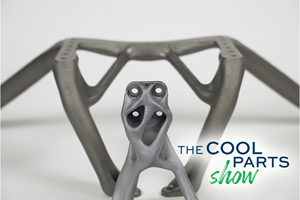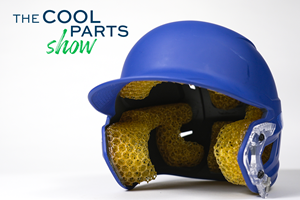3D Printing the World's Smallest Flow Measurement Probes
Vectoflow has found its niche in 3D printing flow measurement probes featuring up to five holes on a probe head diameter as tiny as 0.9 mm.
Share
Read Next
Flow measurement probes gage and predict the speed and angle of attack of an airflow in aircraft and turbo-machinery. The accuracy of prediction of flow is high using conventionally manufactured multi-hole probes, but this accuracy can even be enhanced by manufacturing these probes using powder-bed fusion technology, which helps to, for instance, create turbine blades designed to obtain the desired three-dimensional flow pattern. By measuring differential pressures at the head of the probe, total and static pressure, the angle of attack and velocity of flow can be determined, whether installed in gas turbines, aircraft engines, drones or racing cars.
“The smaller and the more customized the probe, the less the measurement deviation,” explains Katharina Kreitz, one of the three founders of Munich-based Vectoflow. Together with colleagues Christian Haigermoser and Florian Wehner, Kreitz specialized in developing and manufacturing complex flow measurement probes.
“While the probes seem relatively small and fragile, they have to withstand extreme stresses and continue to function reliably at all times, especially in aircraft, where speed is a major factor,” she explains. “During our studies and various projects at renowned companies like Airbus we were quite involved with fluid dynamics but we were all facing the same problem: probes that were not suitable for a specific application, probes that broke easily, software that was almost impossible to understand despite having a PhD in aerodynamics. So we thought there had to be a better solution.”
The solution was additive manufacturing. Using powder-bed fusion technology, the company has developed a unique expertise in manufacturing customized probes that can be perfectly adapted to their application, are smaller, easy to integrate and more robust than conventionally made probes. “Conventional probes need to have their flow channels inside the tube soldered, weak points that often lead to breakage under immense pressure. Manufacturing the probes in one piece offers higher rigidity,” Kreitz says.
Smallest Probes Withstand the Speed of Sound
The smallest probe ever built, according to Kreitz, is a five-hole probe featuring a head diameter of 0.9 mm. There are five tiny independent channels inside this tube, measuring the angle of attack with an accuracy of 1° at a velocity range of 3 m/sec. up to Mach 2, from -50°C up to 1,200°C. But how is it possible to print such an intricate part made of titanium, Inconel or stainless? “For many of our products we are using standard metal AM technology from e.g. EOS or Trumpf,” Kreitz says. “But to make these extremely small parts with such a complex internal geometry considering the diameter, we use a special machine, using powder with a particle size smaller than dust (less than five microns).” The process is conducted in a special atmosphere and according to Kreitz it takes about a full day to print such a small tube because the powder handling is very complicated as the extremely fine dust exposes the worker to health hazards. As a result, the powder is fed to the machine via a special mechanism, using special equipment and gloves.
“With a lot of research and experience anyone could build these parts,” she says. “But anyone could also build his own car. It really takes a lot of experience, special design, considerations how to place the part on the built plate so the channels keep separated from each other inside the tube.”
All of the measuring probes manufactured by Vectoflow can be combined in rakes, leading to a higher spatial resolution (see the photo, above). Here, computational fluid dynamics (CFD) analysis and the flexibility of powder-bed fusion technology allows for an optimum design, where the probe heads are aligned and oriented according to the flow and angle of attack. So-called Kiel probes, an enhanced development based on traditional flow measurement probes, can also be combined in rakes. They enable accurate measurements to be taken, for example, during extreme flying maneuvers or when engines are in a banked position. However, the stresses on the component then increase even further. This is especially the case in the engine, due to the higher thermal loads.
“Our customer, a European research company in the aerospace industry, experienced ongoing problems with probes fracturing because they were made up of multiple parts, which made them unstable. We manufacture our probes in a single piece in order to avoid this type of problem," Kreitz explains. “Additive manufacturing allows us to produce Kiel probes in a single piece. This enables us to implement special functionally integrated designs and attain very small channel and overall sizes."
When modeling the components, Vectoflow also attaches great importance to minimizing the number of possible disruptive factors and their effects, for example the development of undesirable secondary noise, as acoustics measurement was also part of the remit in this case. The engineers also found effective solutions relating to thermal load capacity thanks to the nature of the layered production with the EOS M 290, for instance. The thermal elements measure the temperature of the respective measuring units. The nickel-chromium alloy is even able to withstand high temperatures of up to the required 1,000°C and continue to be fully functional at twice the speed of sound.
Post-Production Treatment
Vectoflow also subjected the components to extensive post-production treatment to optimize the product quality. While many probes do not require any or much post-treatment, specially developed processes like the Micro Machining Process (MMP Technology) give the Kiel probes their extremely smooth surfaces and perfect finish. The deburring/polishing method is a mechanical-physical-chemical surface treatment applied to items placed inside a treatment tank. This optimizes the aerodynamic quality of the probe such that their functions—measuring pressures and temperatures in the boundary layer of the air flowing from the jet engine—are not impaired.
“We received very positive feedback. Unlike probes manufactured using the traditional machining process, our sample was impressively robust,” Kreitz says. “Our component is 150 percent more rigid than conventionally made parts. Moreover, the extremely low thickness, together with the improved aerodynamic design and post-treatment played a major role in allowing the user to obtain very precise measurements."
Related Content
Velo3D Founder on the 3 Biggest Challenges of 3D Printing Metal Parts
Velo3D CEO and founder Benny Buller offers this perspective on cost, qualification and ease of development as they apply to the progress of AM adoption in the future.
Read More3D Printed "Evolved Structures" for NASA Exoplanet Balloon Mission: The Cool Parts Show #61
Generative design creates stiff, lightweight brackets for EXCITE mission monitoring planets orbiting other stars. The Cool Parts Show visits Goddard Space Flight Center.
Read More3D Printed Lattices Replace Foam for Customized Helmet Padding: The Cool Parts Show #62
“Digital materials” resulting from engineered flexible polymer structures made through additive manufacturing are tunable to the application and can be tailored to the head of the wearer.
Read More3MF File Format for Additive Manufacturing: More Than Geometry
The file format offers a less data-intensive way of recording part geometry, as well as details about build preparation, material, process and more.
Read MoreRead Next
Profilometry-Based Indentation Plastometry (PIP) as an Alternative to Standard Tensile Testing
UK-based Plastometrex offers a benchtop testing device utilizing PIP to quickly and easily analyze the yield strength, tensile strength and uniform elongation of samples and even printed parts. The solution is particularly useful for additive manufacturing.
Read MoreBike Manufacturer Uses Additive Manufacturing to Create Lighter, More Complex, Customized Parts
Titanium bike frame manufacturer Hanglun Technology mixes precision casting with 3D printing to create bikes that offer increased speed and reduced turbulence during long-distance rides, offering a smoother, faster and more efficient cycling experience.
Read MoreCrushable Lattices: The Lightweight Structures That Will Protect an Interplanetary Payload
NASA uses laser powder bed fusion plus chemical etching to create the lattice forms engineered to keep Mars rocks safe during a crash landing on Earth.
Read More

.JPG;width=700;quality=80)
.JPG;width=860)
.JPG;width=860)
.JPG;width=860)



















